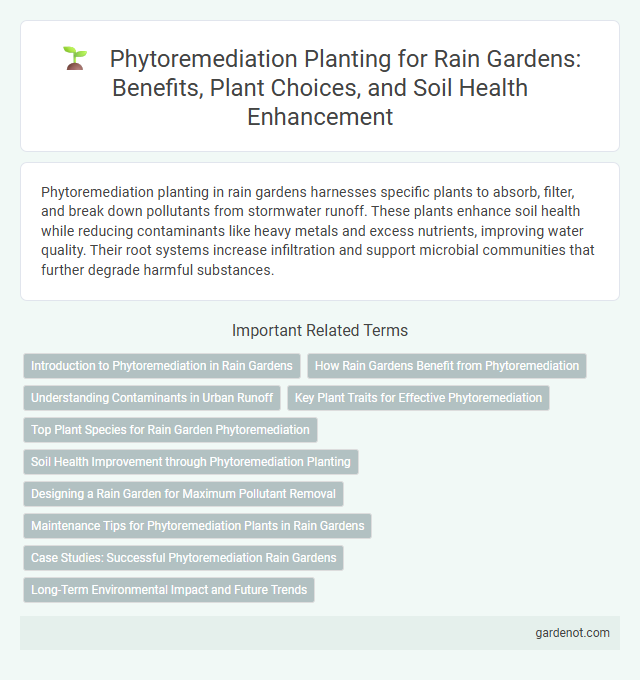Phytoremediation planting in rain gardens harnesses specific plants to absorb, filter, and break down pollutants from stormwater runoff. These plants enhance soil health while reducing contaminants like heavy metals and excess nutrients, improving water quality. Their root systems increase infiltration and support microbial communities that further degrade harmful substances.
Introduction to Phytoremediation in Rain Gardens
Phytoremediation uses specific plants within rain gardens to absorb, degrade, or stabilize pollutants in stormwater, enhancing water quality naturally. These plants, such as native grasses, sedges, and wildflowers, efficiently remove heavy metals, nutrients, and organic contaminants through their root systems. Integrating phytoremediation into rain garden design supports ecosystem health by promoting soil microbial activity and reducing runoff contamination.
How Rain Gardens Benefit from Phytoremediation
Rain gardens benefit from phytoremediation by using specific plants to absorb and break down pollutants such as heavy metals, pesticides, and excess nutrients from stormwater runoff. These plants, including species like cattails and bulrushes, enhance soil microbial activity, which accelerates the degradation of contaminants and improves water quality. Integrating phytoremediation plantings into rain gardens effectively reduces urban pollution, mitigates flooding, and supports sustainable ecosystem restoration.
Understanding Contaminants in Urban Runoff
Phytoremediation planting in rain gardens targets heavy metals, nutrients like nitrogen and phosphorus, and hydrocarbons commonly found in urban runoff. Plants such as Canna indica, Juncus effusus, and Carex spp. absorb, degrade, or stabilize contaminants, reducing pollutants before they reach groundwater or waterways. Understanding contaminant composition guides the selection of effective species to enhance pollutant removal and improve stormwater quality.
Key Plant Traits for Effective Phytoremediation
Phytoremediation planting in rain gardens relies on key plant traits such as deep root systems, high transpiration rates, and tolerance to pollutants for effective contaminant uptake and degradation. Plants with fibrous roots enhance soil aeration and microbial activity, accelerating pollutant breakdown in soil and water. Selecting native species with the ability to accumulate heavy metals and organic compounds maximizes the rain garden's efficiency in stormwater treatment and ecological restoration.
Top Plant Species for Rain Garden Phytoremediation
Key plant species for rain garden phytoremediation include Carex species such as Carex vulpinoidea and Carex stricta, which excel in nutrient uptake and heavy metal absorption. Native wetland plants like Juncus effusus and Pontederia cordata enhance pollutant removal through their extensive root systems and high transpiration rates. These species contribute effectively to water quality improvement by stabilizing soil, reducing runoff, and facilitating microbial degradation of contaminants.
Soil Health Improvement through Phytoremediation Planting
Phytoremediation planting in rain gardens enhances soil health by using specific plants that absorb and break down contaminants, improving soil structure and nutrient cycling. Deep-rooted species like willows and switchgrass increase microbial activity and promote aeration, which supports beneficial soil organisms. This natural remediation process not only reduces pollutants but also boosts soil fertility and resilience in urban landscapes.
Designing a Rain Garden for Maximum Pollutant Removal
Selecting diverse native plants with deep root systems enhances pollutant uptake and improves soil infiltration in rain gardens. Incorporating species such as Carex, Juncus, and Lobelia targets heavy metals, nutrients, and hydrocarbons effectively through phytoremediation. Designing layered planting zones maximizes contaminant absorption by creating microhabitats that support microbial degradation and plant-root interactions.
Maintenance Tips for Phytoremediation Plants in Rain Gardens
Regularly inspect phytoremediation plants in rain gardens for signs of stress or disease to maintain optimal pollutant uptake. Prune dead or overgrown foliage to promote healthy growth and prevent nutrient competition. Ensure soil moisture levels are consistent, avoiding both waterlogging and drought conditions to sustain plant efficacy in contaminant removal.
Case Studies: Successful Phytoremediation Rain Gardens
Phytoremediation rain gardens utilize specific plant species to effectively remove pollutants from stormwater runoff, enhancing water quality in urban environments. Case studies demonstrate that plants like Carex spp. and Juncus effusus can significantly reduce heavy metals and nutrient loads, resulting in improved soil and water health. These successful implementations highlight the vital role of native and adaptable vegetation in sustainable stormwater management systems.
Long-Term Environmental Impact and Future Trends
Phytoremediation planting in rain gardens enhances long-term environmental impact by improving soil health and reducing pollutant levels through natural bioaccumulation and degradation processes. Native plant species with deep root systems maximize contaminant uptake and support biodiversity, leading to sustained ecosystem resilience. Future trends emphasize integrating genetically optimized plants and microbial symbionts to increase efficiency in contaminant breakdown and climate adaptability.
Phytoremediation planting Infographic

 gardenot.com
gardenot.com